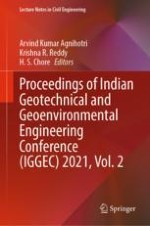This book presents select proceedings of the Indian Geotechnical and Geoenvironmental Engineering Conference (IGGEC-21). Various topics covered in this book include geotechnical engineering, earthquake geotechnical engineering, geoenvironmental engineering, ground improvement, transportation geotechnics, waste management and sustainable engineering. The book will be a valuable reference for researchers and professionals in the discipline of civil, materials, geoenvironmental engineering, landfills, hydrogeology, ground improvement and earthquake geotechnical engineering.
